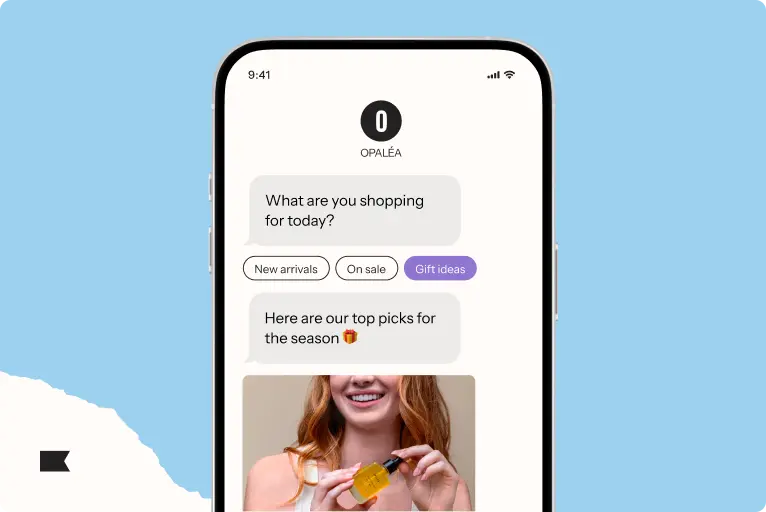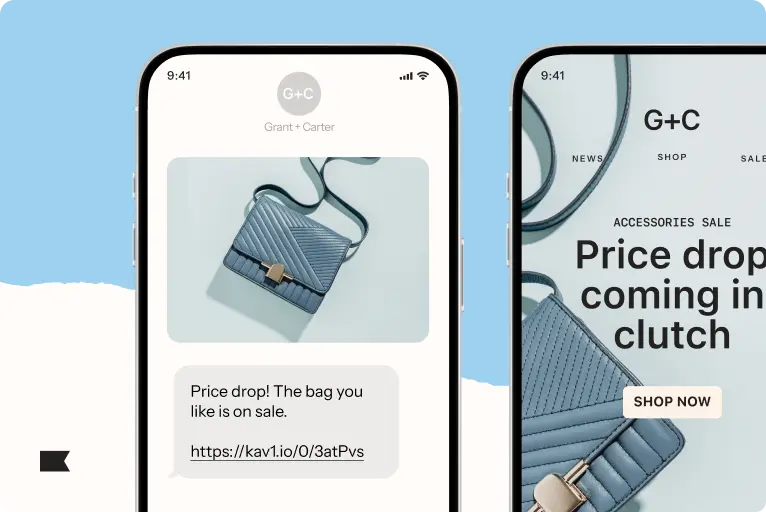Shopify SMS strategy for your online store

Ecommerce platforms like Shopify make it easier than ever to take your small business online, but you can’t stop there.
You also need a marketing strategy to ensure customer acquisition and retention.
In 2022, SMS for your Shopify store is no longer a nice-to-have; it should be part of your overall ecommerce marketing strategy.
Besides email and your website, SMS, short for “short message service,” is one of the few methods of communication that you truly “own.”
Think about it: when you publish something on Twitter, Instagram, Facebook, or another social media network, sophisticated algorithms determine the priority that various posts show up in users’ news feeds.
Your posts could be seen by only a fraction of your overall followers, even if they all sign in and look at their feeds around the same time (or shortly after) you post your message.
Compare this to SMS and email where you have a list of email addresses and phone numbers that your customers have given you.
You choose what you want to send, when you want to send it, and how you want to send it—and as long as you’re following email and SMS best practices, you can guarantee that the message will be delivered (and read 96 percent of the time with SMS).
So how do you take advantage of this ‘owned marketing’ channel?
Keep reading to learn more about how to get started with SMS marketing on your Shopify store by choosing an SMS platform that can integrate with your store and building out your SMS marketing strategy.
Getting started with SMS for Shopify
If you have an existing Shopify store and product to market, you can get started with SMS marketing. But first, you’ll need to choose an SMS provider.
There are a variety of apps in the Shopify app store (like Klaviyo), but in general, you should look for an app that includes the following:
- Easy management of opt-in and opt-out status and consent.
- Compliance with TCPA and other SMS compliance regulations and organizations.
- Options to build your SMS list (such as by easily adding opt-in popups, forms, landing pages, etc.).
- Allows for the sending of SMS campaigns.
- Allows for sending text automation, such as back-in-stock notifications, abandoned cart notifications, etc.
- Allows you to personalize your messages with products, names, and other information you have about your customers.
- Allows you to add images or video (MMS messages).
- Allows you to use short codes and keywords for custom replies.
- Integrates with your Shopify store to pull in customer data, product information, and more.
- Ecommerce focused reporting features such as tracking SMS attribution, ROI, revenue, SMS costs, and more.
- Segmentation and list building capabilities so that you can send targeted messages to the right people at the right time.
Once you’ve selected your Shopify SMS provider, it’s time to create your SMS strategy.
You should never send text messages just for the sake of sending text messages. Not only does each message cost you money (which can add up quickly!), but it’s also a fast way to receive the dreaded “STOP” response from your customers. Nobody wants to receive text spam.
Developing an SMS Marketing Strategy for Shopify
You can break your Shopify SMS marketing strategy down into two parts: text automation strategy, and text campaign strategy.
Before launching either strategy, you should define the goal each and every text you send your customer has. Is it to encourage a specific action such as a purchase? Is it to inform them of a specific sale, promotion, or event that’s happening? Is it to let them know that a product you were out of is back in stock or to remind them that they left items in their cart?
By defining the goal first, you can then determine what specific metrics and key performance indicators (KPIs) to track to help you determine if the text message reaches its goal and if any iterations are needed.
You can also determine the frequency in which texts should be sent, if there’s more than one text message in the campaign series or flow, and which messages should take priority if there’s ever a situation where you need to send multiple texts within a specific time period.
Text Automation Strategy
Text automation is the act of sending text messages when a specific trigger or event occurs.
This can be an event such as somebody adding an item to their cart and not checking out, or a product coming back in stock that a list of users wanted to receive notifications on when it was available again, and much more.
Below is a list of common text automations, which is a great place to start when developing your Shopify SMS strategy.
Top email automation flows that can integrate SMS segments
- Back-in-stock texts: Develop a system on your product pages to allow a user to opt-in to receive a text alert when a product is back in stock. Many users will prefer a back-in-stock text to a back-in-stock email, particularly if it’s a high-demand item that may sell out again quickly since many users check their text messages much more frequently than they check their emails.
- Abandoned cart texts: People are busy and sometimes they add an item to their cart that they’re fully intending to purchase, but then they forget about. These helpful texts are a gentle nudge and reminder to complete the checkout process. Depending on your product and audience, you may want to test adding a discount to further incentivize them to complete their purchase if they are from the cart abandonment segment.
- Order received texts: It’s always a nice reminder to customers when brands confirm a successfully placed order. Provide a helpful link to allow customers to track the status of their order and provide a way for them to contact your business if they have questions.
- Shipping confirmation texts: A shipping confirmation text should include helpful information such as a tracking link and expected date of delivery.
- Welcome series: When a customer opts into your texts (either via a standalone opt-in form or when they opt-in while purchasing), it’s helpful to send a welcome series to help new subscribers get to know your brand.
Text Campaign Strategy
When sending text campaigns, it’s always best to start with the goal in mind. Every campaign should be centered around a specific goal, such as to drive a sale of a particular product or collection.
From there, you can work backwards to determine which KPIs and metrics to track that indicate the success of the campaign, as well as what the messaging should be.
Every SMS campaign should include a call to action (CTA), such as a link to learn more about a subject, a link to view specific products, or an ask for customers to reply with a keyword.
Below is a list of ideas for SMS campaigns for your Shopify store:
- Rewards: Create a loyalty program and use SMS to get people to signup for it.
- Sales and promotions: If you’re having a sale or promotion on your products, SMS is a great way to get the word out. Increase urgency by texting your customers, especially if the promotion is only available for a limited period of time, such as with a flash sale.
- Contests: Everyone likes the chance to win something. Consider using SMS as a platform to promote a contest. Make it easy to opt into the contest by allowing subscribers to reply with an SMS keyword, such as “text SOCKS to opt into our contest to win a new pair of socks!”.
- Helpful tips: Consider sending an SMS campaign to people who’ve purchased a particular product with tips and ideas on how to use it. For example, if you sell plants, you could send a follow-up text message to purchasers on how to take care of their new plant.
- New product announcements: Create hype around a new product by letting your customers know about it.
- Polls and surveys: Feedback is the breakfast of champions, so allow your customers the opportunity to provide feedback or ask them to provide their opinion about how you’re doing.
Final thoughts
Once you have your SMS campaign and automation strategy in place, it’s time to launch your Shopify SMS program!
It’s important to note that SMS is not set it and forget it. You should set aside time each week to review your SMS metrics and KPIs to ensure they’re tracking towards the goals you’ve set. In the beginning, you may want to review these metrics and spend daily to make adjustments as needed.
The good news is that it’s never too late to get started with creating an SMS marketing strategy. Now is the perfect time to start growing your list and your Shopify business with SMS.

Related content

Marketers are right to be cautious right now. The Texas settlement has sparked more questions than clarity—but that’s exactly why taking a compliance-first approach still matters.

Google’s RCS Roadshow and Klaviyo are shaping the future of mobile marketing with AI-powered personalization and trusted, interactive messaging.

Discover 6 key factors to choose the best SMS marketing platform covering integrations, compliance, AI, and pricing to power smarter customer journeys.